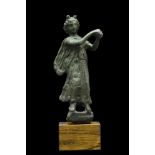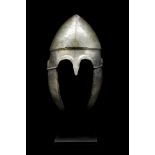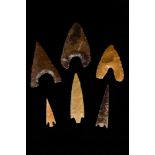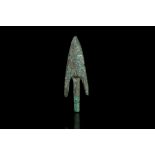Refine your search
Filtered by:
- Category
- List
- Grid
A subscription to the Price Guide is required to view results for auctions ten days or older. Click here for more information
Ca. 100-300 AD. A charming cast bronze statuette is the representation of Diana (in Greek Mythology Artemis), goddess of the hunt, presented in a ...
Ca. 500-300 BC. A beautiful example of a tin bronze Greek Chalcidian helmet. The bowl is forged in one piece, featuring high-arched eyebrows below...
Ca. Naqada II - 1000 BC. A mixed group of six hand knapped arrowheads comprising: three bifacial barbed and tanged and three with prominent wings....
Ca. Naqada II - 1000 BC. A bronze arrowhead with a raised midrib, beveled edges that taper to a pointed tip, and a tang for insertion into a haft....
Second Intermediate Period, 13th - 17th Dynasty, Ca. 1786-1567 BC. The sides flaring to the curved cutting edge, the remnants of the wooden handle...
Predynastic, Naqada II, Ca. 3200-3000 BC. A black polished stone mace head with edged flaring to a curved end, a central socket for attachment to ...
Ca. 400-300 BC. An iron sword of a double-edged blade with deep fuller almost to the tip and straight parallel sides. The bar-shaped guard, hilt, ...
A PSEUDO-CHALCIDIAN HELMET
Northern Black Sea region, 4th century BC . A very expressive form of bronze helmet of Chalcidian type. The Crown domed skull composed of two halv...
Ca. 1200-700 BC. A bronze "Trojan" sword blade with prominent rib, and winged guards that provide protection for the wielder. The blade is sharp a...
ANCIENT BRONZE LONG SPEARHEAD
Ca. 1200-700 BC. A beautiful cast bronze sword witah a tapering, bevelled blade with a raised midrib and a flat tang. Bronze weaponry production f...
Ca. 800 BC. A bronze spear with a triangular blade, rounded shoulders, raised midrib, sharp edges that taper gradually to a pointed tip, long sock...
ANCIENT BRONZE LONG SPEARHEAD
Ca. 1200-700 BC. A long bronze spear with an elongated leaf-shaped blade with raised midrib, sharpened edges that taper gradually to a pointed tip...
ANCIENT BRONZE LONG SPEARHEAD
Ca. 1200-700 BC. A bronze spearhead in a elongated and narrow form, with a thick midrib and a sharp point at the top. Weaponry production in the W...
Ca. 1200-700 BC. A finely cast bronze dagger, comprising a triangular-shaped, double-edged blade with raised mid-rib and a flanged, hollowed hilt....
ANCIENT BRONZE SPEARHEAD
Ca. 1200-700 BC. A bronze spear featuring a leaf-shaped blade with raised midrib, gently curved shoulders, and turned outward tang ending in a sma...
Ca. 800-600 BC. A beautiful bronze hoplite spear with a leaf-shaped blade and a long conical socket. Hoplites were the citizen-soldiers of Ancient...
Ca. 1200-700 BC. A bronze dagger featuring a triangular-shaped blade with a sharp tip, a flanged hilt, and a crescent-shaped pommel. The hilt was ...
ROMAN MARBLE HERCULES TORSO
Ca. 100-300 AD. A marble torso depicting an aged hero Hercules with his head facing forward, wearing the skin of the Nemean lion over his head, th...
Ca. 100-200 AD. Loeschcke Type 1A. A mould-made terracotta oil lamp with concave discus bearing a relief image of a standing, armoured murmillo gl...
ANCIENT ROMAN IRON SPEARHEAD
Ca. 100-300 AD. An iron spear head with a pointed, leaf-shaped blade, and circular socket. The army of ancient Rome (800 BC - AD 476) was a formid...
ANCIENT ROMAN IRON SPEARHEAD
Ca. 100-300 AD. A Roman socketed iron spearhead with an elongated leaf-shaped blade and an integral hollow handle. The sword and spear were the in...
ROMAN BRONZE HARPOON
Ca. 100-300 AD. An iron harpoon consisted of a spiked head and a lateral hook at the top and a conical-shaped socket with a rivet hole at the bott...
Ca. 100-300 AD. An iron pilum spearhead with a barbed, triangular blade, and a long, narrow neck, and a robust flaring socket. Good condition. 'Pi...
Ca. 100-300 AD. A rare mould-made terracotta oil lamp with concave discus bearing a relief scene of the first of twelve labors of Hercules - killi...
Ca. 100-300 AD. A rare mould-made terracotta oil lamp with concave discus bearing a relief scene of the first of twelve labors of Hercules - killi...
Ca. 300-400 AD. An excellent collection of four bronze crossbow brooches, each with three onion-like protrusions, an arched bow, rectangular tail ...
Ca. 5th-2nd century BC. A black stone cylinder seal, from the Graeco-Persian or Macedonian period with a single-register engraving depicting a bat...
NEO-ASSYRIAN STONE CYLINDER SEAL
Ca. 8th-7th century BC. A reddish-black stone cylinder seal from the Neo-Assyrian period. It portrays two fourwinged heros armed with a scimitar a...
AN ELABORATE CELTIC BRONZE SWORD
Ca. 1000-800 BC. The long blade gently broadening below the tip, with medial ridge stepped towards the base and flanked by chased lines, the hilt ...
Ca. 900-1000 AD. Rare Viking period iron helmet; of elongated form in triangular sections; attached with iron rivets passing through this overlap ...
VIKING IRON SWORD
Ca. 825-880 AD. Sword with one edge of the Viking type. The blade is broad with a single fuller running close to one edge. The cross guard is shor...
Ca. 900-1000 AD. A hand-forged Viking iron sword with Brazil nut pommel and decorated guard; the blade is wide at the upper end, gently tapering w...
Ca. 1050-1250 AD. A stunning iron sword Oakshott type ‘B’, of a thin tapering blade with a fuller running from the cross guard to nearly top of th...
VIKING IRON BATTLE AXE HEAD
Ca. 900-1100 AD. An impressive iron bearded axehead with a curved blade and elliptical shaft-hole. A wooden pole would have been placed through th...
VIKING IRON BATTLE AXE HEAD
Ca. 1000-1200 AD. An iron bearded axe head with an elongated, curved blade and tapering cheek. In bearded axes, the main part of the axe blade ext...
VIKING IRON BATTLE AXE HEAD
Ca. 900-1100 AD. An iron axe head comprising a wedge-shaped blade, tapering cheek, reinforced poll, and rounded socket. Further information on Vik...
VIKING IRON BATTLE AXE HEAD
Ca. 900-1100 AD. An iron bearded axe head with an elongated, curved blade and tapering cheek. The bearded axe, or Skeggøx (from Old Norse Skegg, "...
MASSIVE VIKING TWISTED NECK TORC
Ca. 900-1100 AD. A beautiful bronze torc of a round section shank with incised ribbed design. Torcs are found in many European cultures ca. the 8t...
VIKING IRON SPEARHEAD
Ca. 900-1100 AD. An iron spearhead with a leaf-shaped blade, sharp edges flaring slightly before tapering to a pointed tip, and long flared socket...
VIKING IRON SPEARHEAD
Ca. 900-1100 AD. An iron spear head with an angular blade, covered in a rich brown patina. This weapon is comprised of a tubular socket that widen...
Ca. 10th-11th century AD. An iron seax blade with a straight cutting edge and sharply angled back, the tang offset from the blade. Its hilt would ...
Ca. 10th-11th century AD. An iron seax blade with a straight cutting edge and sharply angled back, the tang offset from the blade. Its hilt would ...
VIKING IRON BATTLE AXE HEAD
Ca. 900-1100 AD. An iron bearded axe head with a slender and long curved blade and a square-section poll that may have been used as a hammer. The ...
VIKING IRON BATTLE AXE
Ca. 900-100 AD. This iron battle axe features a rounded socket and a long head, flaring towards the blade. Further information Viking axes can be ...
VIKING IRON WAR HAMMER
Ca. 900-100 AD. An iron axe head comprising a short, curved blade, elongated cheek, lozenge-shaped poll and round socket. Fair condition; mounted ...
VIKING IRON BATTLE AXE
Ca. 900-100 AD. This iron battle axe features a rounded socket and a long head, flaring towards the blade. Further information Viking axes can be ...
VIKING IRON AXE HEAD
Ca. 900-100 AD. A forged-iron axe head of a hefty form with a perforated socketing shaft, a dense neck, and a vertically oriented blade with gentl...
MEDIEVAL IRON FALCHION SWORD
Ca. 13th-14th Century AD. A falchion of the ‘Cusped’ type. Such blades are very rare. Pommel missing. Blade good condition, with minor surface pit...
LATE MEDIEVAL IRON SWORD
Ca. 1436-1475 AD. Short sword with s shaped quillons and a square pommel. The blade appears to be one edged with a double fuller running down the ...
NORMAN IRON SWORD
Ca.1050-1250 AD. Norman sword with a Brazil nut pommel and long straight, thin cross guard. Such swords are classified by Oakshott as a type ‘B’. ...
MEDIEVAL IRON SWORD
Ca.1100-1125 AD. A sword blade of a Viking or Norman type, with deep fuller almost to the tip and straight parallel sides. The blade has no cross ...
NORMAN IRON SWORD - FULL REPORT
Ca. 950-1310 AD. An iron sword with a distinctive Brazil nut pommel, Oakeshott as a type ‘A’. The cross guard is long, thin, and square sectioned,...
Ca. 13th-15th century AD. An iron dagger with a broad triangular blade, S-shaped cross guard, and a pommel shaped as a boot.Size: L:368mm / W:106m...
Ca. 13th-15th century AD. An iron dagger featuring a double-edged blade tapering to a point, an S-shaped cross guard upon a rectangular-section ta...
Ca. 14th-15th century AD. A long iron dagger / stiletto featuring a slender blade with midrib, a long downwards curling cross guard, and a circula...
MEDIEVAL IRON DAGGER
Ca. 1300-1500 AD. Medieval Dagger of near perfect survival. The fittings are of brass and the hilt, (which has survived) is made of bone (or simil...
LATE MEDIEVAL IRON DAGGER
Ca. 14th-15th Century AD. A poniard with iron, disc like fittings that have scalloped edges. The blade is long and thin, much of the same proporti...
MEDIEVAL IRON DAGGER
Ca. 14th-15th Century AD. Medieval dagger with broad triangular blade, rod like cross guard and a round, bar like pommel with ribs on the lower en...
Ca. 1300-1400 AD. A well-preserved paramerion sword with a characteristic single-edged blade of slight curvature, with a religious script running ...
Ca. 800-1000 AD. A late Roman, early Byzantine glazed ceramic grenade, also referred to as "Greek Fire". This hollow ceramic vessel is globular in...





























































